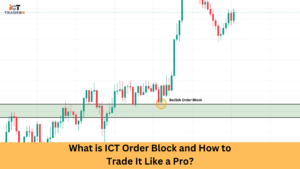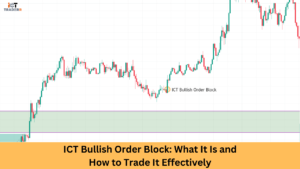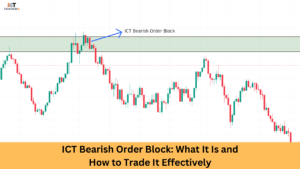Do you want to learn about reclaimed order blocks and improve your trading skills? The ICT Reclaimed Order Block is an important concept under the Inner Circle Trader (ICT) methodology and is about understanding how institutions traded in the market. It is built around the Market Maker Model, where “smart money” (institutional traders) accumulates positions and pushes the market with these order blocks toward their desired destination.
“To fully grasp the idea of a reclaimed order block, You must first understand what an order block is.”
In this article, we will discuss reclaimed order blocks, their types, how to trade them, and several trader mistakes regarding these blocks. Let’s get started!
What is a Reclaimed Order Block?
Reclaimed Order Blocks are areas where institutional traders accumulate their positions, causing a minor price displacement. Once the price revisits these blocks, they act as support or resistance levels, providing traders with potential entry points.
The market moves cyclically, with two primary sides:
- Buy Side: When the market is moving upward.
- Sell Side: When the market is moving downward.
Before diving into Reclaimed Order Blocks, it’s essential to understand the ICT Market Maker Buy Model and ICT Market Maker Sell Model. These models explain how institutional traders manipulate the market to execute their large orders.
Market Maker Buy Model: In this model, smart money accumulates buy positions and uses Reclaimed Order Blocks to push the price higher.
Market Maker Sell Model: In this smart money accumulates sell positions and uses Reclaimed Order Blocks to push the price lower.
Types of Reclaimed Order Blocks
Reclaimed order blocks can be categorized into two main types based on market sentiment:
Bullish Reclaimed Order Block
A Bullish Reclaimed Order Block is a candlestick pattern that forms on the sell side of the market. It indicates a minor price displacement before the market reverses and moves higher. This block is commonly observed in the Market Maker Buy Model.
How to Identify a Bullish Reclaimed Order Block?
- Look for the last down-closed candle before a minor price displacement.
- After the displacement, the price should move upward, reclaiming the block.
- The reclaimed block now acts as a support level for further upward movement.
Real-Life Example:
Imagine the market is in a bullish trend. Before moving higher, it sweeps liquidity by moving downward. During this downward move, institutional traders accumulate buy positions. Once the price reclaims the block, it acts as a support level, pushing the price higher.
Bearish Reclaimed Order Block
A Bearish Reclaimed Order Block is a candlestick pattern that forms on the buy side of the market. It indicates a minor price displacement before the market reverses and moves lower. This block is commonly observed in the Market Maker Sell Model.
How to Identify a Bearish Reclaimed Order Block?
- Look for the last up-closed candle before a minor price displacement.
- After the displacement, the price should move downward, reclaiming the block.
- The reclaimed block now acts as a resistance level for further downward movement.
Real-Life Example:
Imagine the market is in a bearish trend. Before moving lower, it sweeps liquidity by moving upward. During this upward move, institutional traders accumulate sell positions. Once the price reclaims the block, it acts as a resistance level, pushing the price lower.
How to Trade Reclaimed Order Blocks Like a Pro
Step-by-step procedure for trading on the Reclaimed Order Blocks:
Identify Market Trend: Identify if the market is trending upward or downward.
Identify Order Block: Locate the last candle before a minor price shift.
Wait for Reclaim: Wait until the price gets back to the block while confirming that the reversal indeed occurred.
Enter the Trade: Enter trade as soon as the price indicates confirmation (for example: a bullish/bearish engulfing candle).
Stop Loss and Take Profit: Place your stop loss below/above the block and create a realistic take profit.
Common Mistakes & How to Avoid Them
Even experienced traders can make mistakes when trading reclaimed order blocks. Here are some common mistakes to avoid them:
Trading Without Confirmation
Mistake: Getting into a trade before receiving confirmation for the reclaim.
Solution: Wait for obvious price action signals like engulfing candles or breakouts.
Ignoring the Higher Timeframes
Mistake: Depending on the false signals found in the lower timeframes alone.
Solution: Always check order blocks for higher timeframes for much greater credence.
Disregarding Risk Management
Mistake: Not putting stop-loss orders into effect or risking too much on a single trade.
Solution: Follow proper risk management and never, ever overleverage yourself.
Chasing the Market
Mistake: Entering the trade rather late after the price has already moved significantly.
Solution: Have some patience and wait for the price to retrace to the reclaimed zone.
Conclusion
The ICT Reclaimed Order Block is a powerful tool for traders who want to comprehend and take advantage of institutional market movements. You can improve your trading performance and identify high-probability trade setups by mastering this concept. Remember, not every block is tradeable, so always look for additional confirmations and practice proper risk management.
Take advantage of the precision provided by reclaimed order blocks and begin incorporating these insights into your trading strategy!
FAQs
Is the reclaimed order block applicable to all markets?
Definitely. Reclaimed Order Block finds application across all markets – forex, stock indices, and crypto-block.
How do I confirm a reclaimed order block?
Look for price-action confirmations such as engulfing candles, pin bars, or breakouts to confirm a reclaimed zone.
What is the best timeframe for trading reclaimed order blocks?
Reclaimed order blocks formed on higher timeframes such as the 4h or daily charts carry more reliability to identification and trade setup.
Is risk management important when trading reclaimed order blocks?
Absolutely. Good risk management would keep you from losing money and create a consistent long-term profit.



